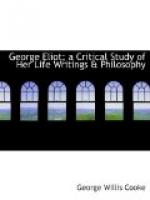manner, of viewing, the greater problems of human
existence. Charlotte Bronte more truly represents
the woman’s way of viewing life; the trustful
way of one educated in the conventional views of religion.
She has given a corrector interpretation of the meaning
of love to woman than George Eliot has been able to
present, and simply because she thought and lived
more nearly as other women think and live. Hers
was the genius of spontaneous insight and emotion,
that vibrated to every experience and was moved by
every sentiment. Life played upon her heart like
the wind upon an Aescolian harp, and she reflected
its every movement of joy and sorrow. George
Eliot studied life, probed into it, cut it in pieces,
constructed a theory of it, and then told us what it
means. In this she was unlike other women who
have made a deep impression on literature. Mrs.
Browning had nearly as much culture, was as thoughtful
as she, but more genuinely feminine at the heart-core.
Love she painted in a purer and happier fashion than
that adopted by George Eliot, and she had the warmer
impulses of a woman’s tenderness. Her account
of life is the truer, because it is the more ideal;
and this may be said for Charlotte Bronte also.
George Eliot had the larger intellect, the keener mind,
was a profounder thinker; but her realism held her
back from that instinctive conception of life which
realizes its larger ideal meanings. It is not
enough to see what is; man desires to know what ought
to be. The poet is the seer, the one who apprehends,
who has that finer eye for facts by which he is able
to behold what the facts give promise of. This
ideal vision Mrs. Browning had, and in so far she
was the superior of George Eliot. The same may
be said for George Sand, who, with all her wildness
and impurity, was a woman through and through.
She was all heart, all impulse, lived in her instincts
and emotions. She had the abandon, enthusiasm
and spontaneity which George Eliot lacked. If
the one represents the head, the other expresses the
heart of woman. George Eliot, as a woman, thought,
reasoned, philosophized; George Sand felt, gave every
emotion reign, lived out all her impulses. What
the one lacks the other had; where one was weak the
other was strong. With somewhat of George Sand’s
idealism and emotional zeal for wider and freer life,
George Eliot would have been a greater writer.
Could she have moulded Dorothea with what is best in
Consuelo, she would have been the rival of the greatest
literary artists among men. Yet, with her limitations,
it must be said that George Eliot is the superior of
all other women in her literary accomplishments.
If others are her superiors in some directions, in
the totality of her powers she surpasses all.
Even as an interpreter of woman’s nature and
the feminine side of life, she does not fail to keep
well ahead of the best of feminine writers. She
is more thoroughly the master of her powers, is more
self-centred, looks out upon human experience more
calmly and with a more penetrating gaze. Foremost
of the half-dozen women who during the present century
have sought to interpret the feminine side of life,
she has done much for her sex. Daring more than
others, she has given a greater promise than any other
of what woman is to accomplish when her nature blossoms
out into all its possibilities.




